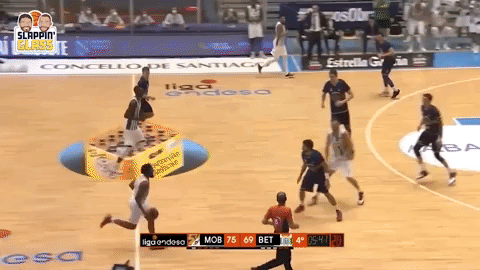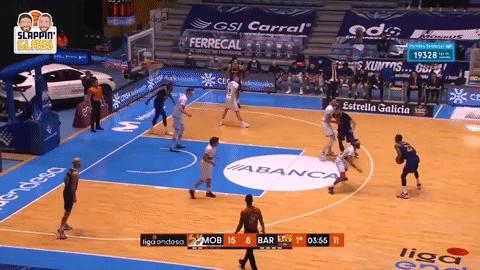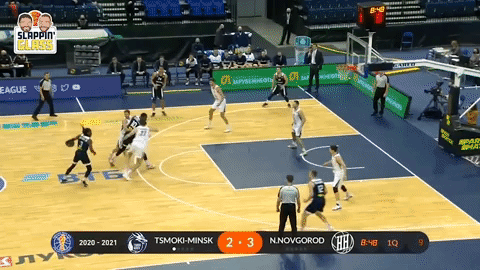PNR Defense: Canceling Screens
Just the Two of Us
Welcome to our “Sunday Mornin’ Newsletter”, where we explore some of basketball’s best ideas, strategies, and coaches from around the world.
In today’s edition we’ll cover:
Canceling the PNR: A Primer on Keeping it a “2 v 2 Game”
Joe Boylan and Zak Boisvert Podcast Insights
Best Sets of the Week
Today’s Free Masterclass with ChampionShift!
Teams to Watch/Interesting Reads
Let’s dive in…
We’re excited to see many of you tonight at 8pm EST for our joint Masterclass with former Phoenix Suns Assistant Coach, Bret Burchard, and his great company, Championshift.
Bret is highly regarded for his work in helping coaches and athletes add and sharpen tools in their coaching toolbox when it comes to mindset training and developing a personal coaching philosophy, and we haven’t logged off InStat or FastDraw for a year, so it was a real “you had me at hello” situation.
From our end, in tonight’s Session we’re going to look at how team’s are currently using these concepts:
Creating Space with Cutters
Turning Cutters into Screeners
Turning Screeners into Cutters
Changing/Confusing “Tag Responsibilities”
Putting the “Tag” between a “Rock and a Hard Place”
We’ve had so much fun putting tonight’s Masterclass together with Bret and the rest the team at ChampionShift, that we decided to create another event for this Spring. We’ll discuss the details and give exclusive access to that forthcoming event for participant’s of tonight’s Masterclass.
We’re looking forward to seeing you all tonight!
PNR Defense: Canceling the PNR
As we inch closer to March, this is typically the time of year when defenses start to find their sweet spot when it comes to combating some of the best offensive actions they’ve encountered. At this point in the season there’s more data, film, and accumulated practice time that coaches can use to tinker with and tighten up their defensive coverages and strategies as playoffs loom near.
Side Note: This is also the time of year when we start to see some great offensive variations by coaches to try and stay a step ahead of the defense. You can listen to our “Extra Pass” Podcast with Zak Boisvert this week for more on that.
With the rise of interesting and effective Ball Screen Actions at all levels, coupled with an increasing amount of Off-Ball Cutting during the PNR, the incentive for defenses to try and keep the PNR a “2 v 2 game” and not involve a 3rd defender is at a premium. At this point in the season offenses are also finding their groove when it comes to creating/keeping an advantage once the defense is in rotation after a PNR. So today, we’re going to look into some of the effective strategies teams are using to “cancel” many of the advantages a PNR creates.
Specifically, we’ll look at the Rules, Teaching Points, and Strategy of the “Quick Show and Recover”, which also encompasses the “Late Switch”.
Side Note: Another very popular tactic in this realm is to simply “switch” the PNR to keep the other defenders out of rotation, but below’s tactics focus on the defense NOT WANTING to switch the PNR on the perimeter.
Here we go…
“Quick Show and Recover”
“Showing” or “Hard Hedging” a PNR is certainly not new, but we wanted to specifically dive into the subtle differences of the “Quick Show and Recover” and why a team may choose to use that coverage to handle a PNR as opposed to an old-fashioned “Hard Hedge”. First, here’s a look at what the “Quick Show and Recover” looks like…
For NBA fans, you can probably visualize this “Quick Show and Recover” during last year’s NBA Finals in which the Lakers would continuously put Duncan Robinson or Tyler Herro as the Ball Screen defender in the PNR against LeBron , especially during late-game possessions. For obvious reasons, the Heat did not want to switch Robinson or Herro onto LeBron, so would utilize this “Quick Show” strategy in an attempt to keep Jimmy Butler/Jae Crowder on LeBron. We spoke about this exact situation a couple weeks ago with Jeff Van Gundy in the “Start, Sub, or Sit?!” segment of the podcast when discussing late-game PNR coverages. We also put an edit out about this NBA Finals Chess Match, you can see HERE.
The subtle differences to highlight as we get started between the “Hard Hedge” and the “Quick Show” comes in the overall philosophy of WHY a team would choose one over the other. In the traditional “Hard Hedge”, the defense often commits their Defensive Big to fully pushing the PNR ballhandler BACK toward the same sideline and rely on the other 3 defenders in Helpside to be prepared to rotate if/when the ball is moved out of the PNR. During the “Hard Hedge” the defensive mindset is often to try and get the ballhandler to give the ball up and force another offensive player to make a play. Also, in the “Hard Hedge”, the length in which the Defensive Big stays with the ballhandler is also longer than the “Quick Show.”
On the other hand, the “Quick Show and Recover”, comes packaged with a slightly different defensive mindset where the defense is trying NOT to be in rotation and is NOT overly concerned about making the PNR ballhandler “give the ball up,” but instead trying to maintain matchups while taking away downhill driving space from the ballhandler.
Simply, the “Quick Show” is an attempt to keep the PNR a “2 v 2 game” and keep the defense OUT OF rotation while the “Hard Hedge” is more likely to force the defense INTO rotation.
“Quick Show Rules/Techniques” — Bigs
To effectively keep the PNR a “2 v 2 Game” in the “Quick Show”, there are a few rules and techniques both the Bigs and Guards most follow. We’ll start with the Bigs…
#1 — Up to Touch
The “Quick Show” will almost certainly fall apart if the Defensive Big is not “up to touch” on the PNR, meaning… up to the level of the ball and able to maintain contact with his Offensive Big. It’s very important for the Defensive Big to “arrive at the same time” as the Offensive Big to effectively plug the gap the ballhandler is trying to get downhilll into…
*Deeper Teaching Point: The reason being “up to touch” is so important is that the job of the Defensive Big in this coverage is to do two things… 1) “Stand the Ballhandler Up” to allow the defensive guard time to recover back to the ball, and 2) “Maintain Contact” with the Offensive Big on the roll so a switch isn’t necessary on the backside. See above how the Defensive Big does a great job of stabbing at the ball and “standing the ballhandler up” while his right hand ALSO maintains contact with the screener. None of this great technique is possible if the Defensive Big doesn’t arrive with the screen and isn’t “up to touch.” If he’s late to the screen, or not “up to touch”, you get situations like this where the Offensive Guard can “split” the PNR…
Side Note: On the other side of the ball, the above GIF shows why a “Drag Screen” in transition can be such a problem for the defense as it’s very difficult for a Defensive Big to be sprinting back in transition AND get “up to touch.” This is why you see most NBA teams simply “Drop/Ice” or “Switch” a Transition Drag Screen to avoid this split.
#2— Late Switch
Even if the defense does a good job of being “up to touch” and plug the gap, crafty/athletic guards will find a way to get downhill and attack the rim. This is why, after the Defensive Big has “stunted” and “recovered” back to the rolling Offensive Big, they still need to be prepared for a “Late Switch” onto the ballhandler at the rim.
*Deeper Teaching Points: In the GIF above, the Defensive Big does a great job of finding the Offensive Roller and then immediately swiveling his head back to find the ball. This quick head swivel allows him to make the good decision to come over and “late switch” onto the guard as he attempts to block the shot. Above, we also start to get into the crossover of the “Guard Rules” in the “Show and Recover” as the Guard’s job on the “late switch” is to try and use the Offensive Big’s momentum against him to push/pin him under the rim and limit the offensive rebounding advantage created by the “late switch.”
“Quick Show Rules/Techniques” — Guards
Continuing to look at the Rules/Techniques of the Guards in this coverage, here are a few of the key ones.
#1— “Ride the Hip Over”
One of the most important things for the guard in this situation is to “fight over the top of the screen” while also doing their best to “maintain contact” with the ballhandler. This is important in taking away any pull up three attempt while also leveling the ball. In a perfect world of carefully curated GIFs to drive home a point, it would look something like this…
#1b— “Don’t Die on the Screen”
This is really a rule on all screens, but with the way the “Quick Show” coverage is designed, the Defensive Guard cannot “die on the screen.” This opens a huge gap and forces rotations from the other defenders. As shown in our breakdown video below, it’s important for the guard to do their best to maintain contact and not open themselves up to be easily screened.
#2 — “Beat Them to the Spot”
We spoke about this concept with Joe Boylan in Friday’s latest podcast about how the best defender’s in the NBA like Jrue Holiday understand how to “turn and run” and “beat the ballhandler to a spot” rather than continuing to ride them on their hip. When done well it looks something like this…
And…even if the defender can’t beat the offense to the spot on the perimeter right away, they should continue to sprint to level the ballhandler somewhere deeper toward the rim.
*Deeper Teaching Points: It’s impossible to take everything away in a PNR, and the Guard’s responsibilities within this coverage is to limit the options of the ballhandler while maintaining a level of ball pressure. It does take more concerted effort from the Defensive Guard to fight over the top, level, and maintain pressure the whole time, but, winning is hard.
In closing, we’ll quickly mention the other defensive philosophy when trying to keep the PNR a “2 v 2 Game”, and that is the “Drop/Ice Coverage”. Like the “Show and Recover”, using “Drop Coverage” also limits the amount of weakside help needed to solve the PNR and relies on the communication and effort of the 2 defensive players involved in the action. When deciding between the “Show and Recover” and “Drop Coverage”, coaches will look at a variety of factors, one being the abilities of the primary ballhanders and rim rollers they’ll face. The “Show and Recover” does a good job of providing more coverage on the Rim Rolling Big, and takes away more of the Lob threat since the Defensive Big stays connected the them. So, if the ballhandler in the PNR is more of a facilitator and less of a threat to score than the Rim Rolling Big, then the “Show and Recover” is a livable option for the defense as they can stay connected to shooters and rollers and force the ballhandler to be a scorer.
The potential downside of the “Show and Recover” is that it puts a ton of pressure on the defensive guard to be able to successfully fight over screens and recover back to their man. Also, unlike the “Drop Coverage”, where the defense can often dictate sending the ball “down” towards the baseline, keeping it to one side of the floor, or forcing to a “weak hand”, the “Show and Recover” does at times allow the ball to “get middle” and the defense must be comfortable handling that middle penetration 30-40 times a game.
Additional Resources
You can watch our Full Breakdown video of the Quick Show and Recover here…
It was a busy week on the Slappin’ Glass Podcast as we released our 2nd episode of the “Extra Pass” as well as our normal Friday episode. We were lucky to have two fantastic guests exploring very different areas of the sport.
First, on Tuesday we welcomed back former podcast guest, Zak Boisvert, for our 2nd episode of the “Extra Pass”. These “Extra Passes” are shorter (20-30 minute) conversations surrounding a single topic. We sat down with Coach Boisvert and explored a variety of new “Euro Continuity Actions” that teams are running around the world. It’s always a pleasure to have Coach Boisvert’s time and thoughts, and he gives a very thorough breakdown in 20 minutes. We also published a full breakdown video and newsletter of the actions.
On Friday, we also welcomed former NBA Assistant and owner of Hoops Mind, Joe Boylan. We dove into a number of terrific On AND Off-the-Court topics including:
Mindfulness, Meditation, and Emotional Control
Individual Defensive Technique including Jrue Holiday’s “Float Step”
Coaching/Motivating Bench Players
The return of “Overrated/Underrated?!”
Best Coaching Investments
And more…
From working on mindfulness and emotional balance as a coach, to the nerdiest of “X and O” conversations, we hope there’s something you find useful from this week’s great guests.
Listen Now…
Thank you to those who have given us a rating and review on Apple. If you have a second and can do so, it really does help the podcast continue to grow and be discovered by others. You can do that HERE. Thank you!
Best Sets of the Week
In this week’s Best Sets we look at:
“Burn Cutting Behind a Screen”
“Gator Action” on the 2nd Side
The Beautiful Offensive World of Ryan Pannone
And more…
Teams to Watch/Interesting Reads
Some teams we enjoyed watching this week:
Erie Bayhawks (G-League)
Crailsheim (German BBL)
Yeshiva University (NCAA D3)
Basquete Unifacisa (Brazil - NBB)
Interesting Reads:
Victim of External Circumstances (by Masterclass collaborator Bret Burchard)
Thank you for reading and for the support. We look forward to seeing many of you tonight at the Masterclass.
Have a great week coaching,
Dan and Pat
Tools We Use
We are proud to partner with InStat for our video software. It’s how we access all our European/NBA/NCAA games, as well as shot charts, analytics, and much more. We created a tutorial about how we use it HERE.
Members of our newsletter can get 10% off of InStat. If interested please email us at slappinglass1024@gmail.com.












Hey Todd! All of our past newsletters, masterclasses, breakdown videos, and more have been moved to SG Plus. You can find more info about it here...https://tv.slappinglass.com/catalog
Thanks again!
Is it possible to still get access to this Masterclass?